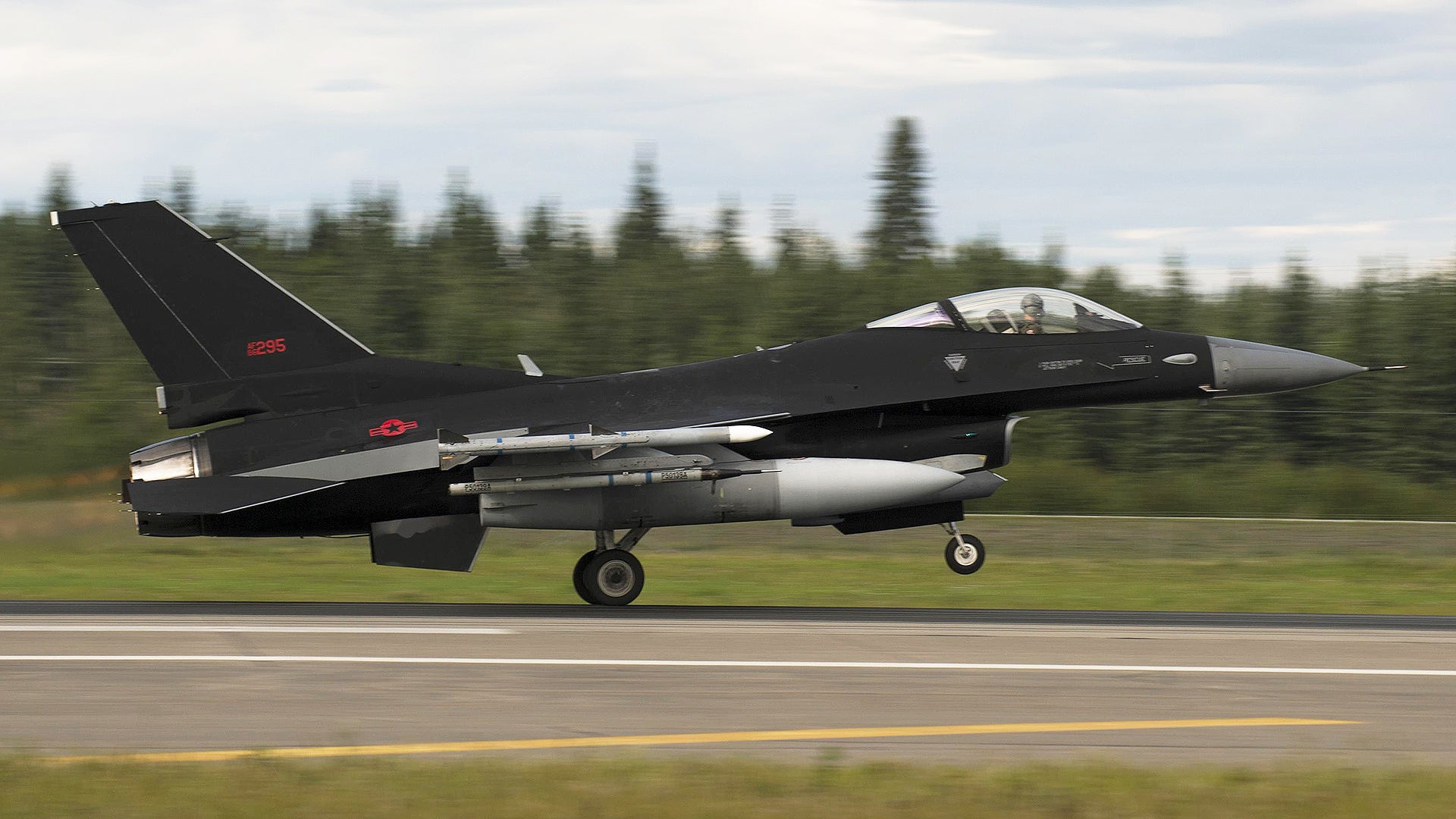Exercise Red Flag Alaska is underway, and as usual Eielson Air Force Base’s own 18th Aggressor Squadron (AGRS) is hard at work playing the bad guy. The Alaska-based aggressors are adorned with some awesome looking paint schemes, and recently they debuted their “splinter blizzard” motif. But an entirely new look popped up for this Red Flag Alaska—a sinister, light-sucking flat black with red highlights paint job—an iconic look most known for its use on the SR-71 Blackbird and U-2 Dragon Lady reconnaissance aircraft than on potentially hostile fighters.


Then again, the scheme does feature some gray tones, most notably on the F-16’s radome. This is somewhat similar to what China’s prototype J-31 fighter flew with, but that aircraft was far from production, with the type now flying in its second and more refined developmental configuration. The first examples of the larger and more advanced J-20 also wore a similar dark gray and red scheme.

The scheme is also reminiscent of the ones flown on the “MiG-28s” (F-5E/Fs) during the making of Top Gun. Navy’s F-5 aggressor community—which includes—VFC-111 out of NAS Key West and VFC-13 out of NAS Fallon, Nevada—still paints at least one of their jets in this famous “Hollywood” scheme, although it is high gloss black, not flat black.

The paint job could also be some historical callback to the P-61 Black Widow night fighter, an aircraft that also wore red details over a flat black paint job. The 18th AGRS traces its roots back to before World War II. During the war the unit’s predecessor, the 18th Fighter Squadron, flew P-39s, P-40s, P-51s and P-38s, but there doesn’t seem to be a direct connection to the squadron and the P-61 Black Widow.

Creative new adversary paint jobs have come back in vogue as of late, with USAF and Navy aggressor squadrons introducing some pretty smashing and relevant schemes in recent years. As for Eielson’s 18th Aggressor Squadron, the unit flies more advanced and powerful F-16s than their higher profile counterparts, the 64th Aggressor Squadron, based at Nellis AFB. In recent months, 18th AGRS Vipers have been seen flying with advanced EL/L-8212 electronic warfare pods and Sniper targeting pods, the former of which can also be used for long-range air-to-air optical detection and identification. It isn’t clear if the 18th AGRS has a secondary air defense role like their Nellis based counterparts.
Red Flag 17-3, which runs from July 27th through August 11th, mirrors Red Flag exercises that take place over the Nellis Range Complex in Nevada, with some differences. Namely, the ranges in Alaska, many of which are instrumented, are enormous, and can include a more varied array of assets. As an Eielson press release states, “the Joint Pacific Alaska Range Complex; the largest instrumental air, ground and electronic combat training range in the world, covering more than 67,000 square miles.”

Red Flag was originally designed decades ago to give aircrews their first ten “combat missions” in a hyper-realistic training environment. In many ways this has not changed, although the mock air battles have gotten far more complex and now includes live virtual constructive training and little seen elements of space, electronic and cyber warfare as well.

According to the USAF, Units participating in Red Flag Alaska 17-3 include:
“The 18th Aggressor Squadron, Eielson AFB, Alaska; the 80th Fighter Squadron, Kunsan Air Base, Republic of Korea; the Electronic Attack Squadron 138, Naval Air Station Whidbey Island, Wash.; the 391st Fighter Squadron, Mountain Home AFB, Idaho; the 425th Tactical Fighter Squadron, Canadian Forces Base Bagotville, Canada; the 437th Transport Squadron, Canadian Forces Base Trenton, Canada; the 909th Air Refueling Squadron, Kadena AB, Japan; the 168th Air Wing, Eielson AFB, Alaska; the 96th Bomb Squadron, Barksdale AFB, La.; the 210th Rescue Squadron, Joint Base Elmendorf-Richardson, Alaska; the 746th Test Squadron, Holloman AFB, New Mexico; the 129th and 131st Rescue Squadrons out of Moffett Air National Guard Base, Cali.; and the Naval Special Warfare Special Operations Forces from Virginia.”
We have reached out to Eielson AFB and the 18th AGRS to find out more about this evil looking new aggressor scheme.
Contact the author: Tyler@thedrive.com
